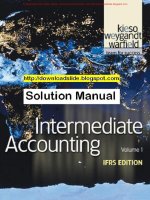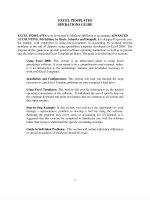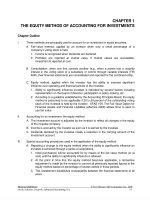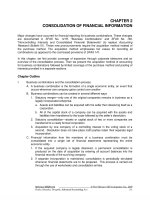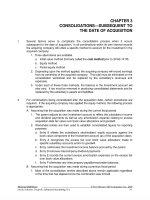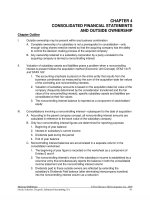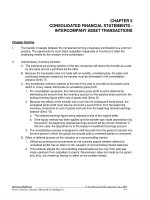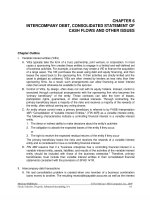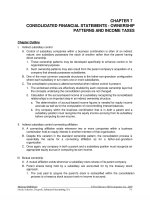Solution manual intermediate accounting 9e by nicolai ch03
Bạn đang xem bản rút gọn của tài liệu. Xem và tải ngay bản đầy đủ của tài liệu tại đây (749.03 KB, 58 trang )
To download more slides, ebook, solutions and test bank, visit
CHAPTER 3
THE BALANCE SHEET AND STATEMENT OF CHANGES IN STOCKHOLDERS’ EQUITY
CONTENT ANALYSIS OF EXERCISES AND PROBLEMS
Number
Content
Time Range
(minutes)
E3-1
Current Assets. Partial balance sheet preparation from listed
accounts.
E3-2
Plant and Equipment. Partial balance sheet preparation from
general information.
10-15
E3-3
Stockholders' Equity. Partial balance sheet preparation from
listed accounts.
5-10
E3-4
Balance Sheet. Matching various accounts with major
sections.
5-10
E3-5
Balance Sheet. Matching various accounts with major
sections.
5-10
E3-6
Balance Sheet. Preparation from accounts listed in random
order. Calculation of debt ratio.
15-20
E3-7
Balance Sheet. Preparation from accounts listed in
alphabetical order. Calculation of working capital and current
ratio.
15-20
E3-8
Balance Sheet Calculations. Calculate missing information,
given amounts of selected balance sheet elements.
15-25
E3-9
Balance Sheet Calculations. Calculate missing information,
given amounts of selected balance sheet elements.
15-25
E3-10
Corrections. Preparation of a properly classified balance sheet
from one prepared erroneously.
10-15
E3-11
Changes in Stockholders' Equity. Stock issuance, income
earned, dividends paid. Statement of changes in stockholders'
equity.
10-15
E3-12
Changes in Stockholders' Equity. Stock issuance, income
earned, dividends paid. Statement of changes in stockholders'
equity.
10-15
3-1
5-10
To download more slides, ebook, solutions and test bank, visit
Number
Content
Time Range
(minutes)
P3-1
Balance Sheet. Matching various accounts with major
sections.
15-30
P3-2
Balance Sheet. Format preparation, no amounts.
20-40
P3-3
Balance Sheet. Preparation from accounts listed in
alphabetical order. Identification of possible disclosures.
Computation of working capital and current ratio.
30-45
P3-4
Balance Sheet. Preparation from accounts listed in random
order.
20-40
P3-5
Balance Sheet. Preparation from alphabetical adjusted trial
balance. Calculation of debt ratio.
20-30
P3-6
Balance Sheet. Preparation from accounts listed in random
order. Notes. Calculation of current ratio, liquid assets, and
separable assets.
45-60
P3-7
Comprehensive. Preparation of balance sheet from accounts
listed in alphabetical order. Notes. Statement of changes in
stockholders' equity. Calculation of debt ratio and discussion.
75-90
P3-8
Corrections. Preparation of a properly classified balance sheet
from one prepared incorrectly, using account breakdowns.
30-45
P3-9
Corrections. Preparation of a properly classified balance sheet
from one prepared incorrectly, using additional available
information.
30-45
P3-10
Balance Sheet Calculations. Calculate missing information,
given amounts of selected balance sheet elements.
20-30
P3-11
Errors. Identification of balance sheet errors. Preparation of a
properly classified balance sheet from one prepared
erroneously.
30-45
P3-12
(AICPA adapted). Complex Balance Sheet. Preparation of
corrected balance sheet from unaudited balance sheet and
additional information.
45-60
P3-13
Changes in Stockholders' Equity. Stock issuance, treasury stock,
paid dividends, donation, earned income. Statement of
changes in stockholders' equity.
10-15
P3-14
Balance Sheet Disclosures. Questions relating to the review of
The Coca-Cola Company balance sheet disclosures in
Appendix A.
20-40
3-2
To download more slides, ebook, solutions and test bank, visit
ANSWERS TO QUESTIONS
Q3-1
The major financial statements of a company are:
1.
A balance sheet, which summarizes the company's financial position at the end
of the accounting period.
2.
An income statement, which summarizes the results of operations of the
company for the accounting period.
3.
A statement of cash flows, which summarizes the cash inflows and cash
outflows of a company for the accounting period.
Many companies also include a statement of changes in stockholders' equity, which
summarizes the changes in each item of a company's stockholders' equity for the
accounting period, as a fourth major financial statement.
Q3-2
The financial position of a company includes its economic resources (i.e., assets),
economic obligations (i.e., liabilities), and equity, and their relationships to each other
at a moment in time.
Q3-3
One purpose of a company's balance sheet is to provide information about its
liquidity, financial flexibility, and operating capability. A second purpose of the
balance sheet is to provide a basis for evaluating the company's income-producing
performance during a period.
Q3-4
Liquidity refers to how quickly an asset of a company can be converted into cash or
a liability paid. Financial flexibility refers to the ability of a company to use its financial
resources to adapt to change. Operating capability refers to the ability of a
company to maintain a given physical level of operations.
Q3-5
Financial capital is the monetary value of the net assets contributed by stockholders
and the value of the increase in net assets resulting from earnings retained by the
corporation (cumulative income in excess of cumulative dividends). Capital
maintenance refers to maintaining the stockholders' equity of the corporation in
order to provide a return of investment. Information about the maintenance of a
corporation's capital is important in assessing the adequacy of a corporation's
profitability and its ability to provide a return on investment.
Q3-6
Recognition is the process of formally recording and reporting an element in the
financial statements. It includes depiction of an element in both words and numbers,
with the amount included in the totals.
Q3-7
An asset is a probable future economic benefit obtained or controlled by a
company as a result of a past transaction or event. To be considered an asset, an
economic resource must have three characteristics. First, the resource must singly, or
in combination with other resources, have the capacity to contribute directly or
indirectly to the company's future net cash inflows. Second, the company must be
able to obtain the future benefit and control others' access to it. Third, the
transaction or event giving the company the right to or control over the benefit must
have already occurred.
3-3
To download more slides, ebook, solutions and test bank, visit
Q3-8
A liability is a probable future sacrifice of economic benefits arising from a present
obligation of a company to transfer assets or provide services to other entities in the
future as a result of a past transaction or event. An obligation of a company must
have three characteristics to be considered a liability. First, it must entail a
responsibility to another entity or entities that will be settled by a sacrifice involving
the transfer of assets, providing services, or other use of assets at a specified or
determinable date, on occurrence of a specified event, or on demand. Second, the
responsibility must obligate the company in a way that it has little or no discretion to
avoid the future sacrifice. Third, the transaction or other event obligating the
company must have occurred.
Q3-9
Stockholders' equity is the residual interest in the assets of a corporation that remains
after deducting its liabilities.
Q3-10
The five alternatives for measuring (valuing) assets are: historical cost, current cost to
replace, current market value in orderly liquidation, net realizable value in due
course of business, and present value of future cash flows. The latter four alternatives
are ways of measuring the fair value of an asset. Historical cost is the valuation
method usually used in a company's balance sheet.
Q3-11
A company's balance sheet is divided into three major sections each with the
components as follows:
1. Assets
a.
Current assets
b.
Long-term investments
c.
Property, plant, and equipment
d.
Intangible assets
e.
Other assets
2. Liabilities
a.
Current liabilities
b.
Long-term liabilities
c.
Other liabilities
3. Stockholders' equity
a.
Contributed capital
(1) Capital stock
(2) Additional paid-in capital
b.
Retained earnings
c.
Accumulated other comprehensive income
Q3-12
Current assets are cash and other assets that are expected to be converted into
cash, sold, or consumed within one year or the normal operating cycle, whichever is
longer.
Current assets may include five items: (1) cash (and cash equivalents), (2) temporary
investments in marketable securities, (3) receivables, (4) inventories, and (5) prepaid
items.
Current liabilities are obligations whose liquidation is expected to require the use of
existing resources properly classified as current assets, or the creation of other current
liabilities within one year or the normal operating cycle, whichever is longer.
3-4
To download more slides, ebook, solutions and test bank, visit
Q3-12 (continued)
Examples of current liabilities are accounts payable, taxes payable, unearned rent,
salaries payable, estimated liabilities for warranties, and the current portion of longterm debt.
Q3-13
A company's operating cycle is the average time taken by the company to spend
cash for inventory, process and sell the inventory, and collect the receivables,
converting them back into cash.
Working capital of a company relates primarily to the financial resources utilized in its
operating cycle.
Working capital is computed by subtracting current liabilities from current assets.
Q3-14
a. If management expects to hold investments for more than one year or the
operating cycle, whichever is longer, these investments are classified as longterm. Long-term investments include:
1. Noncurrent investments in available-for-sale debt and equity securities.
2. Investments in held-to-maturity debt securities.
3. Investments in noncurrent notes receivable of unaffiliated companies and
long-term advances to unconsolidated affiliated companies.
4. Financial instruments (such as options to buy stock) that are noncurrent.
5. Investments in property and equipment being held for use in future
operations.
6. Special funds established for long-term purposes, such as the retirement of
bonds or the acquisition of equipment.
7. Miscellaneous investments, such as the cash surrender value of life insurance.
b. All tangible assets used in the operations of a company are classified as property,
plant, and equipment. They include:
1.
2.
3.
4.
5.
Land
Buildings
Equipment
Natural resources
Leased equipment under capital leases
3-5
To download more slides, ebook, solutions and test bank, visit
Q3-14 (continued)
c. Economic resources that are used in the operations of the business but that have
no physical existence are classified as intangible assets. They include:
1.
2.
3.
4.
5.
Q3-15
Patents
Copyrights
Franchises
Trademarks
Goodwill
a. Obligations that are not expected to require the use of current assets or are not
expected to create current liabilities within one year or the normal operating
cycle (whichever is longer) are classified as long-term liabilities. They include:
1.
2.
3.
4.
5.
6.
b.
Bonds payable
Long-term notes payable
Capital lease contract obligations
Mortgages payable
Pension obligations
Obligations under noncurrent financial instruments
Other liabilities are miscellaneous liabilities not meeting the definition of either a
current or long-term liability. They include:
1. Deferred income taxes payable
2. Obligations of a segment of the company that is being discontinued
3. Long-term advances from customers
Q3-16
A bond is a written promise to pay a specified interest rate and to repay a specific
amount (its face value) at some future maturity date.
Bonds payable may be disclosed on a company's balance sheet as follows:
Long-term liabilities
10% bonds payable outstanding, due
January 1, 2010
Less: Unamortized bond discount
Q3-17
$100,000
(15,000)
$ 85,000
a.
Capital stock are the shares of stock that a corporation is authorized to issue as
evidence of ownership in that corporation. There are two types of capital
stock, preferred stock and common stock. Preferred stock has a preference
over common stock as to dividends. Common stock carries the right to vote at
the annual stockholders' meeting and to share in residual profits.
b.
Additional paid-in capital represents the amount paid to the corporation by
stockholders in excess of the par value of the stock issued.
c.
Treasury stock is the capital stock of a corporation that has been issued but
reacquired by the corporation.
3-6
To download more slides, ebook, solutions and test bank, visit
Q3-17 (continued)
d.
Retained earnings is the amount of corporate earnings that has not been
distributed to stockholders as dividends.
e.
Deficit is the term used to describe a negative retained earnings balance.
f.
Accumulated other comprehensive income is the other comprehensive
income [from items such as unrealized increases (gains)or decreases (losses) in
the market value of investments in available-for-sale securities] that a
corporation has accumulated to date.
Q3-18
Investments by owners are increases in the equity of a company resulting from
transfers of something valuable to the company from other entities in order to obtain
or increase ownership interests. Distributions to owners are decreases in the equity of
a company caused by transferring assets, rendering services, or incurring liabilities to
owners. Many companies report these items in a statement of changes in
stockholders' equity.
Q3-19
Examples of accounting policies that are disclosed in the notes accompanying a
company's financial statements include:
1.
2.
3.
4.
5.
6.
Basis for consolidation
Depreciation and amortization methods
Inventory pricing method
Method for recognition of profits on long-term contracts
Revenue recognition method for franchise and leasing operations
Methods of foreign currency translation
The disclosure of accounting policies is important because it enables the external
users of financial statements to see:
1. What method is employed by the company among existing acceptable
alternatives.
2. Whether any method peculiar to the industry is used by the company.
3. Whether there are any unusual or innovative applications of generally accepted
accounting principles.
Q3-20
Financial instruments include such items as notes payable and receivable, contracts
for loan commitments, collateralized mortgages, interest rate swaps, and put and
call options on stocks. A company is also required to disclose the fair value of all its
financial instruments (both assets and liabilities), whether recognized or not on the
balance sheet, as well as all significant concentrations of credit risk due to its
financial instruments. A company is required to disclose information such as the types
of derivative financial instruments it holds, its objectives in holding the instruments,
and its strategies for achieving these objectives. The description must indicate the
company's risk management policy in regard to each type of instrument.
3-7
To download more slides, ebook, solutions and test bank, visit
Q3-21
A loss contingency is a condition, situation, or circumstance that exists for a company
on its balance sheet date involving uncertainty as to possible losses that it may incur if
some future event occurs.
The following criteria are required for a company to accrue a contingent liability:
1. It is probable that a liability has been incurred (or an asset impaired), and
2. The amount of the loss can be reasonably estimated.
If either of these criteria is not met, a company discloses a contingent liability in a
note accompanying its financial statements.
Q3-22
Usually a time lag of several weeks or months exists between the end of a company's
accounting period and the date of the issuance of its annual report. During this time,
it is possible for significant business events and transactions to occur, which, if not
disclosed in the company's annual report, would cause this report to be misleading.
When subsequent events occur that provide additional evidence concerning
conditions that existed on the balance sheet date and significantly affect the
estimates the company used in the preparation of its financial statements, an
adjustment is made to the financial statements. Subsequent events that provide
evidence concerning conditions that did not exist on the balance sheet date but
occurred after that date are disclosed in the form of a note, in pro-forma ("as if")
statements, or in an explanatory paragraph in the audit report, depending on the
materiality of the financial impact.
Q3-23
For related-party transactions, a company must disclose (1) the nature of the
relationship involved, (2) a description of the transactions, (3) the dollar amount of
the transactions, and (4) any amounts due to or from the related parties on the
balance sheet date.
Q3-24
Comparative financial statements provide current as well as past financial
information about a company. Such information enables a trend to be drawn of the
company's activities, thus yielding useful insights into the prediction of the company's
future performance.
Q3-25
In an audit the certified public accountant is responsible for making an examination
of the accounting system, records, and reports of a company in accordance with
generally accepted auditing standards and, based on this examination, expressing
an opinion as to the fairness of the company's financial statements and
accompanying notes in accordance with generally accepted accounting
principles. The opinion, or auditor's report, usually provides external users with
additional confidence that the reported financial statements and notes are a fair
presentation of the company's financial resources, obligations, and activities.
Q3-26
The SEC "integrated" disclosures that most regulated companies include in their
annual reports are:
(1)
Comparative financial statements. These include comparative balance sheets
for two years and comparative income statements and statements of cash
flows for three years.
3-8
To download more slides, ebook, solutions and test bank, visit
Q3-26 (continued)
(2)
Selected financial data. These include (for a five-year period) net sales or
operating revenues, income (loss) from continuing operations and related
earnings per share, total assets, long-term obligations and redeemable stock,
and cash dividends declared per share.
(3)
Management's discussion and analysis. This involves a discussion and analysis of
the company's financial condition, changes in financial condition, and results of
operations. It includes, at a minimum, specific information about short-term
and long-term liquidity and capital resources, a narrative discussion of the
impact of inflation on sales and on income from continuing operations,
explanations of material changes in financial statement items between years,
and known events and uncertainties expected to impact future operations.
(4)
Common stock market prices and dividends. Information included here
consists of the principal trading markets for the company's common stock, the
high and low market prices for each quarter in the last two years, the
approximate number of stockholders, the dividends paid in the last two years,
and any dividend restrictions.
Q3-27
Under International Accounting Standards, on a company's balance sheet long-term
assets are listed first followed by current assets. Then, capital and reserves are listed,
followed by long-term liabilities. Current liabilities are listed last.
Q3-28
The report form of the balance sheet takes a vertical format in which the asset
accounts are listed first and the liability and stockholders' equity accounts are listed in
sequential order directly below the assets. In the account form, the balance sheet is
organized in a horizontal fashion, with the asset accounts listed on the left-hand side
and liabilities and stockholders' equity accounts listed on the right-hand side.
Q3-29
Additional information not included in the accounts reported on a company's
financial statements can be disclosed by the following alternative methods.
1. Notes are used to describe narrative information and to provide additional
monetary amounts (and sometimes supplemental schedules).
Examples include:
1.
b.
Summary of significant accounting policies
Contingent liabilities
2. Supporting schedules are used to complement an entire financial statement or
explain a summary amount on a specific financial statement. Examples include:
a.
b.
Retained earnings statement
Itemization of long-term liabilities
3. Parenthetical notations are used to explain such items as the method of valuation
or of determining the ending inventory, or to cross-reference certain related asset
and liability accounts. Examples include:
3-9
To download more slides, ebook, solutions and test bank, visit
Q3-29 (continued)
3. (continued)
a.
b.
c.
Q3-30
Lower of cost or market method of valuing inventories
The FIFO method of valuing ending inventory
Cross-referencing a bond sinking fund to the related bonds payable
When preparing and writing financial reporting notes, the accountant should (1)
specify what data are to be disclosed (by reference to related generally accepted
accounting principles), (2) outline the desired format, (3) use short sentences, (4) use
terminology understandable to the non-accountant, and (5) be concise but
complete.
ANSWERS TO CASES
C3-1
There are several alternative valuation methods other than historical cost that a company
could use to measure the value of an asset. First, the current cost of an asset might be
measured in terms of the amount of cash (or equivalent) that would be required on the
date of the balance sheet to obtain the same asset. Methods for obtaining the current
cost of an asset include quoted market prices, the use of specific price indexes, and the
use of appraisals. Inventories, which include goods held for resale in the normal course of
business, or in the case of a manufacturing company, raw materials and goods in process
inventories, are listed at their market value (current cost) when that value is lower than
cost.
Second, the current market value of an asset might be measured in terms of the amount
of cash (or equivalent) that could be obtained on the date of the balance sheet by
selling the asset, in its present condition, in an orderly liquidation. A current market value
would be determined by obtaining a quoted market price for the sale of an asset of
similar kind and condition. Short-term marketable securities are listed at their current
market (fair) value.
Third, the value of an asset might be determined by measuring its net realizable value. This
method values the asset at the amount of cash (or equivalent) into which the asset is
expected to be converted in the ordinary operations of the company, less any expected
conversion costs. It is based upon expected future sales proceeds of the asset and is
sometimes referred to as expected exit value. Both accounts receivable and notes
receivable are listed at their estimated collectible amounts (net realizable values).
A fourth alternative valuation method is present value. The present value of an asset is the
net amount of discounted future cash inflows less the discounted future cash outflows
relating to the asset. The estimated cash flows used to determine present value are similar
to those used to determine net realizable value with the exception that in the present
value approach consideration is given to the time value of money. Long-term investments
(i.e., bonds) may be listed at their present value, depending on the type of investment.
3-10
To download more slides, ebook, solutions and test bank, visit
C3-2
Contingent liabilities are conditions that exist on a company's balance sheet date
involving uncertainty as to possible losses that the company may incur should some future
event occur. Two types of disclosures are generally made relating to contingent liabilities:
1.
An estimated loss is accrued (reported) if it is probable that a liability has been
incurred and the amount of the loss can be reasonably estimated.
2.
If either of the above conditions is not met, the company discloses the loss
contingency in the notes to its financial statements.
The disclosure of contingent liabilities is important in providing external users with additional
information which may help them in predicting the use of financial resources by the
company in the future.
Subsequent events are significant business events or transactions that occur between a
company's balance sheet date and the date of issuance of its annual report. There are
two different types of subsequent events:
1.
Those that provide additional evidence concerning conditions that existed on the
balance sheet date and significantly affect the estimates the company used in the
preparation of the financial statements. For these subsequent events, an adjustment
is made to the financial statements.
2.
Those that provide evidence concerning conditions that did not exist on the
company's balance sheet date, but instead occurred after that date. For these,
disclosure is in the form of a note, pro-forma ("as if") statements, or in an explanatory
paragraph of the audit report.
Since a company's annual report is not issued for some time after the close of the year,
disclosure of subsequent events is necessary for a set of fair, more informative, and
complete financial statements. The failure to report subsequent events may cause its
financial statements to be misleading.
C3-3 (CMA adopted solution)
Note to Instructor: This case is slightly more advanced than the text explanation, but is
useful for class discussion.
1.
The major classes of information that must be included in both the annual report to
shareholders and Form 10-K filed with the SEC are:
audited financial statements.
five-year summary of selected financial data.
management's discussion and analysis of financial condition and results of operations.
market data disclosure for common stock and related security holder matters.
3-11
To download more slides, ebook, solutions and test bank, visit
C3-3 (continued)
2.
a.
Incorporation by reference permits the corporation to cross-reference schedules from
other documents. Information from the proxy or corporate annual report may be
substituted by reference for various sections of the 10-K to avoid repetition of already
available data.
b.
The integrated disclosure system reduces management's efforts in filing annual
reports with the SEC because the SEC is asking for essentially the same information as
is already provided on the uniform financial statements or other documents. Thus,
repetition of already available data is avoided, and the time and cost to file reports
are reduced.
c.
The SEC's principal reasons for making the changes in the annual reporting process
are to improve disclosure to investors and other users of financial information and to
achieve a single disclosure system at a reduced cost.
d.
Potential problems the integrated disclosure system could have on the annual
reporting process from the aspect of financial information are that:
Information overload in the annual report could cause users greater difficulty in
understanding and analyzing the report.
The quality of disclosure may decline as there may be less control over how data
are presented.
C3-4
To:
President
From: Accountant
I am writing in response to your question concerning the recording of property, plant, and
equipment at the current appraised cost. Although this method would increase our
reported 2004 earnings, it is not appropriate.
According to GAAP, property, plant, and equipment is measured and recorded at the
exchange price (historical cost) minus any accumulated depreciation. Consequently,
reporting it at current cost would violate this historical cost concept. In addition, by using
current cost and showing a gain in this year, we would be reducing comparability, not
only between our own financial statements of past years, but also between our financial
statements and those of other companies that follow GAAP. This would create an ethical
issue because we would appear to have higher earnings than a company using GAAP,
which might put us at an unfair advantage regarding the market price of our stock and
our ability to sell stock and borrow money.
Furthermore, because we are using a method which is not in compliance with GAAP, our
auditor would be required to disclose this in the auditor's report. If the difference between
using historical cost and current cost were material enough, it may prevent the auditor
from giving us an unqualified opinion. Such a result would greatly harm our reputation to
external users.
3-12
To download more slides, ebook, solutions and test bank, visit
C3-4 (continued)
Although our goal is ultimately to increase the value of our company's stock and satisfy
the investment requirements of our stockholders, using a method which is not GAAP to
manipulate our asset values and earnings is unethical in that it is unfair to (justice criterion),
violates the rights of (rights criterion), and does not optimize the satisfaction (utility
criterion) of our various stakeholders (e.g., current and potential investors, creditors,
suppliers, community, etc). Therefore, it will be more beneficial to our company in the
long run if we report our property, plant, and equipment at historical cost in accordance
with GAAP, even though it results in lower earnings, than to ignore GAAP and mislead our
external users.
C3-5
Historical cost is the method primarily used to measure the "value" of the various assets
reported on the balance sheet of a company. In general, each asset is recorded at the
exchange price of the transaction in which the asset is obtained. Usually this exchange
price is then reported in the entity's balance sheet until another exchange has taken
place. Certain modifications to this general rule are made for specific assets. The
valuation and reporting of specific assets are discussed below.
Cash is reported at its monetary value. Temporary investments in marketable securities
are reported at their market (fair) value (current market value). Receivables are reported
at their estimated collectible amounts (net realizable values). Inventories are reported at
their cost or market value (current cost), whichever is lower. Finally, prepaid items are
reported at their historical cost, less any amortized amount.
Long-term investments can be reported in several ways. They may be listed at their
market (fair) value, historical cost, book value, or present value, depending on the type of
investment. Property, plant, and equipment, on the other hand, are measured and
reported at their historical cost adjusted for depreciation, with the exception of land
which is listed at its historical cost. Property, plant, and equipment that has been impaired
is reported at its lower fair value. In addition, a capital lease is initially recorded as an
asset at the present value of the future lease payments and is amortized in a manner
similar to other legally owned assets of the company. Intangible assets with a finite useful
life are reported on the balance sheet at their book values. Intangible assets that have
been impaired are reported at their lower fair value.
The "value" of the $1,100,000 total assets is determined by summing the "values" reported
for the individual assets. Thus, the $1,100,000 total assets reported in the balance sheet
does not represent the total current value of the company's assets.
With respect to the common stock, the $1,000,000 total value of the outstanding common
stock will ordinarily not agree with the total "value" of the assets reported on the balance
sheet for several reasons. First, as discussed above, the amount reported for total assets
does not reflect the current values of the individual assets. Second, the company may
hold economic resources that are valuable but are not reported on the balance sheet
because they do not meet the definition of an asset. Finally, the accounting equation
states that the total of the assets is equal to the sum of the liabilities and stockholders'
equity; that is, assets are not only financed by common stockholders, but by creditors and
preferred stockholders as well. The comparison has totally ignored the liabilities and
preferred stockholders' equity.
3-13
To download more slides, ebook, solutions and test bank, visit
C3-6 (AICPA adapted solution)
Note to Instructor: The answer to this case also involves a discussion of the impact on
earnings, discussed in Chapter 4.
1.
Valuation of assets is a significant issue because of its effect on the statement of financial
position and the statement of earnings. The valuation method used affects the
measurement of total assets and the timing and amount of periodic net earnings. This
relationship between asset valuation and measurement of net earnings is referred to as
"articulation" between these two financial statements.
2.
Historical-cost valuation reports assets at their acquisition cost (net of depreciation,
depletion, or amortization, if applicable) and is the total of exchange prices to obtain an
asset and render it suitable for use. Such valuation is measured by the cash or cash
equivalent sacrificed in exchange for the asset. There is an inherent assumption that a
stable monetary unit exists.
Because acquisition cost is the vital measurement, that amount for limited life assets is
allocated on a reasonable basis to future periods as expense or as a factor in the cost of
goods sold (if inventory). It is, therefore, the actual past purchase price that affects the
future period's measurement of net earnings under the matching concept. Because of
this emphasis on matching each period's revenue and expense, the earnings statement
emerges as the primary financial statement based on a transactions approach and the
statement of financial position becomes partly a statement of un-allocated past costs for
nonmonetary assets.
Concerning allocation to the earnings statement under historical-cost valuation, gains are
normally recognized in the period they are realized through sale or use. Unrealized gains
are not considered. Unrealized losses, theoretically, should be treated the same as
unrealized gains; nevertheless, conventional accounting practice permits recognition of
some unrealized losses. This inconsistent treatment is justified under the doctrine of
conservatism.
Historical cost adjusted to reflect general price-level changes is a valuation method that
uses the historical cost (previously discussed) of nonmonetary assets and applies a general
price-level index to reflect changes in the standard unit of purchasing power, the dollar,
so that the information reported is not biased by changes in the ability of the dollar to
command goods and services. In this way, information reported in successive periods
(time-series data) would be expressed in terms of a constant unit of measure.
Nonmonetary assets are, therefore, stated in terms of the units of general purchasing
power as of the date of the statement. These adjusted amounts do not measure any form
of "current value" except by coincidence.
Monetary assets (cash, accounts receivable, etc.) are fixed claims to units of purchasing
power that are the same as the units of dollars. Nonetheless, holding net monetary assets
(monetary assets in excess of monetary liabilities) during a period of rising prices causes a
general price-level loss because these assets represent a fixed claim to reduced
purchasing power. A general price-level gain occurs by holding net monetary assets
during periods of falling prices (or by being a net debtor in periods of rising prices). These
general price-level losses and gains would be shown on a company's earnings statement.
They reflect, in part, the stewardship of management during a period of changing price
levels.
3-14
To download more slides, ebook, solutions and test bank, visit
C3-6 (continued)
2. (continued)
Discounted-cash-flow valuation is one method that yields a "current-value" measurement.
Under this approach, assets are reported at the present value of their estimated future net
cash inflows. Thus, it is considered a future exchange price. It reflects the notion that
assets represent future service potential (economic benefits) and an attempt should be
made to measure this potential (benefit) for reporting.
When using the discounted-cash-flow approach, net earnings would be equal to the
discounted amount of stockholders' equity at the beginning of the period multiplied by
the rate used to discount the future net cash flow. This reflects the amount that could be
paid out to stockholders and still leave the business as "well off" at the end of the period as
it was at the beginning of the period.
Market-price valuation yields a different "current-value" measurement. Under this
approach, assets are reported at their present realizable sales prices at the date of the
statement of financial position. These selling prices should be market selling prices of
similar assets under conditions of orderly sales, rather than liquidation selling prices under
conditions of forced sales. Use of current market selling prices is an indicator of present
cash equivalents of the assets and reflects existing market alternatives; such use does not
assume that these assets will necessarily be sold at those prices.
When using the market-price approach, net earnings would equal net assets (assets minus
liabilities) at the end of the period plus capital withdrawals and dividends, less capital
additions and net assets at the beginning of the period. Net earnings are, therefore,
based on the valuation of the company's assets (and liabilities) because these assets
generate such earnings. Net earning are not based on a transactions approach and,
therefore, do not include arbitrary cost allocations to an accounting period.
Replacement-cost valuation yields another, and different "current-value" measurement.
Under this approach, assets are reported at the market price quoted to acquire them
(replacement in kind). Current replacement cost, which may be approximated by using a
specific price index or by appraisals, reflects supply and demand for the specific asset(s) in
question. Replacement-cost valuation can be based upon either replacement in kind or
replacement or equivalent services or benefits.
When using the replacement-cost approach, net earnings include earnings computed by
the transactions approach and gains or losses from holding assets (and liabilities) whose
purchase prices rise or fall. The earnings statement thus contains some unrealized items
(from a conventional viewpoint). Part of the traditionally determined net earnings would,
under replacement-cost accounting, be reclassified as holding gains or losses. The
earnings statement would show earnings from operations by deducting from current
revenue the cost to replace the goods and services consumed in generating that
revenue, plus holding gains or less holding losses resulting from changes in the
replacement cost of the resources (and obligations) held.
3-15
To download more slides, ebook, solutions and test bank, visit
C3-7
1.
A description of all significant accounting policies of a company must be included as an
integral part of its financial statements. Generally, the disclosures should encompass a
discussion of the principles relating to revenue recognition and asset allocation,
particularly when these principles and methods involve (1) a selection from existing
acceptable alternatives, (2) principles and methods peculiar to the industry in which the
company operates, and (3) unusual or innovative applications of generally accepted
accounting principles. Examples cited include, among others, those policies related to
the basis for consolidation, depreciation methods, amortization of intangibles, inventory
pricing, recognition of profits on long-term contracts, and revenue recognition from
franchise and leasing operations.
2.
a.
The consolidated financial statements include the accounts of the company and all
subsidiaries except where control is temporary and does not rest with the company.
b.
Marketable securities that are highly liquid and have maturities of three months or less
at the date of purchase are classified as cash equivalents.
c.
Inventories are valued at the lower of cost or market. In general, cost is determined
on the basis of average cost or first-in, first-out (FIFO) methods.
d.
Property, plant, and equipment are stated at cost and are depreciated principally
by the straight-line method over the estimated useful lives of the assets.
e.
Trademarks and other intangible assets are stated on the basis of cost and are
amortized, principally on a straight-line basis, over the estimated future periods to be
benefitted (not exceeding 40 years). Trademarks and other intangible assets are
periodically reviewed for impairment to ensure they are appropriately valued.
Accumulated amortization was approximately $285 million at December 31, 2001.
f.
The company expenses production costs of print, radio, and television
advertisements as of the first date the advertisements take place. Advertising costs
of approximately $52 million were included in prepaid expenses and other assets and
noncurrent other assets at December 31, 2001.
3-16
To download more slides, ebook, solutions and test bank, visit
C3-8
Note to Instructor: This case does not have a definitive answer. From a financial reporting
perspective, GAAP is identified and summarized. From an ethical perspective, various
issues are raised for discussion purposes.
From a financial reporting perspective, this is considered a subsequent event. If a
subsequent event occurs that provides additional evidence about conditions that existed
on the balance sheet date and significantly affects an estimate used in preparing the
financial statements, an adjustment is made to them. If the subsequent event occurred
after the balance sheet date, an adjustment is not made. Instead, the information is
disclosed in a note, pro forma statements, or an explanatory paragraph in the audit
report, depending on its materiality. Thus, if there is sufficient evidence that some or all of
Travis Company's $50,000 account receivable will not be collected and the uncollectibility
existed at the end of 2004, then recognition of a loss and a writedown of the accounts
receivable should be made in Davenport's 2004 financial statements. If there is sufficient
evidence of the uncollectibility but it did not occur until 2005, then a note (or other)
disclosure is appropriate.
From an ethical perspective there are several primary stakeholders, including the creditors
and stockholders of Davenport Corporation, the creditors and stockholders of Travis
Corporation, Jim Davenport, and Ted Travis. If the loss and writedown are recognized, this
will decrease Davenport Corporation's income and working capital which may have an
adverse affect on Davenport's ability to provide a return to stockholders and pay
creditors. It may also affect users' perceptions of Jim Davenport's ability to manage the
company. Recognition of the loss by Davenport may also provide "corroborating"
evidence of Travis Corporation's financial difficulty, which may adversely affect its
creditors, stockholders, and president. Disclosure in the notes (or elsewhere) may have
similar, but less significant effects. From an ethical perspective, the critical questions are
what, if any, reporting of the financial difficulty of Travis in Davenport's annual report is fair
and just, and whether the reporting would respect the rights of stakeholders?
The questions that are important from financial reporting and ethical perspectives in this
situation are how reliable is the newspaper report, what is meant by financial difficulty,
and when did the financial difficulty of Travis occur. Additional information must be
gathered concerning each of these questions. For instance, there are times when
newspaper reports misstate the facts. What is the source of the newspaper report; can it
be corroborated? In regard to financial difficulty, how is this defined and how serious is it?
Financial difficulty may mean that sales or income have decreased, but cash flows are
sufficient to pay creditors. And, if there is serious financial difficulty, was this in existence at
the end of 2004 or did some significant event occur in early 2005 to cause it? There are
three alternative courses of action from financial reporting and ethical perspectives: (1)
recognize the loss, (2) disclose the financial difficulty in a note (or other means) to the
financial statements, or (3) not report anything in regard to Travis. The action to select will
depend on the answers to the preceding questions. If there is sufficient evidence that
Travis Company is in serious enough financial difficulty to jeopardize the collection of its
receivable and the difficulty existed at the end of 2004, then from financial and ethical
perspectives, it is appropriate for Davenport Company to recognize a loss and writedown
the receivable.
3-17
To download more slides, ebook, solutions and test bank, visit
C3-9
Note to Instructor: This case does not have a definitive answer. From a financial reporting
perspective, GAAP is identified and summarized. From an ethical perspective, various
issues are raised for discussion purposes.
From a financial reporting perspective, the note receivable from the president is the result
of a related party transaction of Spaedy Company. For this transaction, GAAP requires
disclosures of the nature of the relationship involved, a description of the transaction, the
dollar amount, and the amount due from the president. GAAP does not specify where (or
how) on the balance sheet the receivable from a related party should be classified. The
note could be classified as a current asset if it is expected to be collected in 2005, or as a
noncurrent asset if it is expected to be collected later than 2005.
From an ethical perspective, where this note is classified and how it is reported may have
an impact on the rights of, and fairness to, the various stakeholders. These stakeholders
include the creditors, stockholders, and president of Spaedy Company. If the note is
classified as a current asset in the usual manner (which would increase the working capital
and current ratio) as suggested by the president, this might reflect positively on
perceptions of the president's management. However, since there is no specified due
date, there is considerable uncertainty that it will be collected in 2005. Without additional
evidence (say, from the board of directors) that the note will be collected in 2005, a
normal current asset classification would misrepresent the liquidity of and risk associated
with the company. This would violate the rights of and be unfair to creditors who might
expect the proceeds from the collection to be available for payments to them, as well as
the stockholders who might perceive there is less risk of investment in the company
because of its higher current ratio and working capital. Even if it was determined that
repayment by the president is likely to occur in 2005, so that the note is classified as a
current asset, for full disclosure the note should not be reported as a routine note
receivable. Rather, it should be labeled something like "note receivable from officer" so
that users can make whatever adjustments they feel are appropriate to the current ratio
and working capital. If additional evidence does not support a likely payment in 2005,
then a noncurrent classification with a similar title is appropriate for the note receivable.
3-18
To download more slides, ebook, solutions and test bank, visit
C3-10
Note to Instructor: Students are expected to cite references from the FASB Current Text or
FASB Original Pronouncements in their research of this issue. Students may use the
discussion at the end of the "current liabilities" section in this chapter for general reference.
To:
Head Accountant
From: Assistant Accountant
I have researched the issue of how to report the $100,000 note payable (that is due on
March 6, 2005) on the Tyler Corporation's December 31, 2004 balance sheet. Recall that
the company issued common stock for $80,000 on January 5, 2005 and intends to use the
proceeds (plus $20,000 cash it already has on hand) to repay the note payable on March
6. This situation falls under the category of a "short-term obligation expected to be
refinanced." According to the FASB Current Text, par. B05.113 (FASB Original
Pronouncements, FAS 6, par. 9-11), a company excludes a short-term obligation from its
current liabilities if it intends to refinance the obligation on a long-term basis and it has the
ability to do so. The company can demonstrate its ability to refinance the short-term
obligation by issuing equity securities after the date of its balance sheet but before the
date that the balance sheet is issued. B05.114 (FAS 6, par. 12) goes on to state that the
amount of the short-term obligation that is excluded from current liabilities shall not
exceed the proceeds of the equity securities issued. Footnote 9 of B05.113 (FAS 6, par 11,
footnote 2) also states that the amount of the short-term obligation excluded from current
liabilities (because of the issuance of equity securities) is not included in owners' equity.
Finally, B05.118 (FAS 6, par. 15) indicates that the company must include a general
description of the equity securities issued in the refinancing.
The Tyler Corporation intends to refinance the $100,000 note payable on a long-term basis
and has demonstrated its ability to do so by issuing its common stock for $80,000.
Therefore, based on the preceding generally accepted accounting principles, I
recommend that Tyler Corporation report $20,000 of the note payable as a current liability
and $80,000 as a long-term liability. My reasoning in regard to the amounts is that only the
portion of the short-term obligation that is equal to the proceeds ($80,000) may be
excluded from current liabilities. My reasoning as to the classification of the $80,000 as a
long-term liability is that the excluded amount should not be reported as stockholders'
equity because the common stock had not yet been issued on the balance sheet date. I
also recommend that Tyler Corporation include a note to its financial statements which
indicates that $80,000 of the $100,000 note payable is to be refinanced by the issuance of
2,000 shares of the company's $10 par common stock after the balance sheet date.
ANSWERS TO MULTIPLE CHOICE
1.
d
3.
a
5.
b
7.
c
9.
d
2.
d
4.
a
6.
b
8.
c
10.
b
3-19
To download more slides, ebook, solutions and test bank, visit
3-20
To download more slides, ebook, solutions and test bank, visit
SOLUTIONS TO EXERCISES
E3-1
JENKINS COMPANY
Current Asset Section of Balance Sheet
December 31, 2004
Current Assets
Cash:
On hand
In bank
Marketable securities (short-term)
Accounts receivable
Less: Allowance for doubtful accounts
Inventory
Prepaid items:
Insurance
Office supplies
Total current assets
$ 1,120
5,400
$ 6,520
3,380
$15,600
(1,100)
$ 1,530
970
14,500
19,700
2,500
$46,600
E3-2
MOEN CORPORATION
Property, Plant, and Equipment Section of
Balance Sheet
December 31, 2004
Cost
$ 19,000
170,000
44,000
14,500
17,900
$265,400
Land
Buildings*
Factory machinery
Office equipment
Office furniture
Totals
Accumulated
Depreciation
–
$51,000
31,100
8,200
6,500
$96,800
*Includes office building with cost and accumulated depreciation of
$50,000 and $15,000, respectively, and factory building with cost
and accumulated depreciation of $120,000 and $36,000, respectively.
3-21
Book
Value
$ 19,000
119,000
12,900
6,300
11,400
$168,600
To download more slides, ebook, solutions and test bank, visit
E3-3
GRAF CORPORATION
Stockholders' Equity Section of
Balance Sheet
December 31, 2004
Contributed Capital
Preferred stock, $100 par
Common stock, $10 par
Premium on preferred stock
Premium on common stock
Total contributed capital
Retained Earnings
Accumulated Other Comprehensive Income
Total
Less: Treasury stock (at cost)
Total Stockholders' Equity
$ 65,400
47,100
39,600
53,900
$206,000
209,000
8,200
$423,200
(7,600)
$415,600
E3-4
1.
2.
3.
4.
A
G√
I
A
5.
6.
7.
8.
G
D
K √+
I
9.
10.
11.
12.
F
G
D
J√*
13.
14.
15.
F
C
B
+The
unrealized decrease is a negative (although not strictly a contraaccount) component of Accumulated Other Comprehensive Income.
*Although the letter is checked, the Deficit account is not a contra-account
to retained earnings. Instead, it is the title given to a negative retained
earnings balance.
E3-5
1.
2.
3.
4.
5.
6.
7.
A
G
C
J√*
A
D
B
8.
9.
10.
11.
12.
13.
14.
F
C√
D
B
A√
B
F
15.
16.
17.
18.
19.
20.
H
I
G
A
I
C
21.
22.
X Treasury stock (at cost) should be
subtracted from the sum of contributed
capital, retained earnings, and
accumulated other comprehensive
income to arrive at total stockholders'
equity.
K
*Although the letter is checked, the Deficit account is not a contra-account to
retained earnings. Instead, it is the title given to a negative retained earnings
balance.
3-22
To download more slides, ebook, solutions and test bank, visit
E3-6
1.
BAGGETT COMPANY
Balance Sheet
December 31, 2004
Assets
Current Assets
Cash
Accounts receivable
Less: Allowance for doubtful accounts
Inventory
Prepaid items
Total current assets
Long-Term Investments
Notes receivable (due 2006)
Sinking fund to retire bonds payable
Total long-term investments
Property, Plant, and Equipment
Land
Buildings
Less: Accumulated depreciation
Equipment
Less: Accumulated depreciation
Total property, plant, and equipment
Intangible Assets
Patents (net)
Total Assets
$ 4,300
$ 12,600
(1,600)
11,000
7,400
1,800
$ 24,500
$16,400
5,000
21,400
$12,200
$ 57,400
(21,000)
$ 28,700
(9,700)
36,400
19,000
67,600
4,600
$118,100
Liabilities
Current Liabilities
Accounts payable
Income taxes payable
Wages payable
Total current liabilities
Long-Term Liabilities
Bonds payable (due 2014)
$ 23,000
Premium on bonds payable
1,400
Notes payable (due 2007)
Total long-term liabilities
Other Liabilities
Advances from customers (long-term)
Total Liabilities
(continued on next page)
3-23
$13,100
3,800
1,400
$ 18,300
$24,400
6,000
30,400
2,600
$ 51,300
To download more slides, ebook, solutions and test bank, visit
E3-6 (continued)
1. (continued)
Stockholders' Equity
Contributed Capital
Preferred stock, $100 par
Common stock, $10 par
Premium on preferred stock
Premium on common stock
Total contributed capital
Retained Earnings
Total Stockholders' Equity
Total Liabilities and Stockholders' Equity
$18,600
12,700
7,900
9,300
$ 48,500
18,300
$ 66,800
$118,100
2. Debt ratio = Total liabilities Total assets
43.4% = $51,300 $118,100
E3-7
1.
HITT COMPANY
Balance Sheet
December 31, 2004
Assets
Current Assets
Cash
Marketable securities (short-term)
Accounts receivable
Less: Allowance for doubtful accounts
Inventory
Total current assets
Property, Plant, and Equipment
Land
Buildings
Less: Accumulated depreciation
Equipment
Less: Accumulated depreciation
Total property, plant, and equipment
Intangible Assets
Patents (net)
Trademarks
Total intangible assets
Total Assets
$ 2,900
6,100
$ 21,500
(800)
$ 66,900
$30,000
$144,000
(53,000)
$ 72,400
(35,100)
(continued on next page)
3-24
20,700
37,200
91,000
37,300
158,300
$ 9,800
3,700
13,500
$238,700
To download more slides, ebook, solutions and test bank, visit
E3-7 (continued)
1. (continued)
Liabilities
Current Liabilities
Accounts payable
Current taxes payable
Salaries payable
Total current liabilities
Long-Term Liabilities
Bonds payable (due 2018)
Less: Discount on bonds payable
Total long-term liabilities
Total Liabilities
$22,400
10,400
2,000
$ 34,800
$77,000
(6,900)
70,100
$104,900
Stockholders' Equity
Contributed Capital
Preferred stock, $100 par
Common stock, $10 par
Additional paid-in capital on preferred stock
Additional paid-in capital on common stock
Total contributed capital
Retained Earnings
Accumulated Other Comprehensive Income
Unrealized increase in value of marketable securities
Total Stockholders' Equity
Total Liabilities and Stockholders' Equity
2.
Working capital = Current assets - Current liabilities
$32,100 = $66,900 - $34,800
Current ratio = Current assets Current liabilities
1.92 = $66,900 $34,800
3-25
$21,000
30,000
11,500
24,000
$ 86,500
46,200
1,100
$133,800
$238,700
